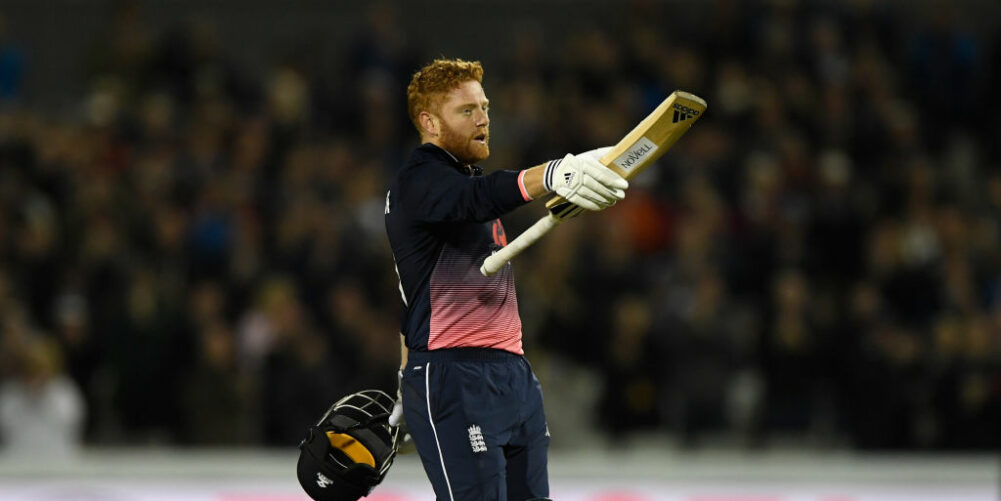(Photo: Getty Images)
By Peter Hayter
Jonny Bairstow biffed the ball from off-spinner Ashley Nurse through the covers, bustled through for two of the three runs he needed to complete his first ODI century, slipped when turning for the third and finally belted down the other end to make it.
Lots of words beginning with B there, none of them beautiful.
And that is the beauty of Bairstow; in white-ball cricket as well as the Test format he has always known his value as a batsman was about content and hang the style and finally, after his man-of-the match innings in the first ODI against West Indies at Old Trafford, the penny must surely have dropped for England, too.
You suspect that had his great friend and admirer Joe Root been running the ODI side, it would have happened long ago, but the decision to retain Bairstow in the position at the top of the order he took over from Jason Roy during the ICC Champions Trophy, may prove to be highly significant to England’s chances of winning the 2019 World Cup.
Bairstow’s supporters, Root among them, need no reminding that he made his ODI debut as long as six years ago and that, since then, he has played just 28 matches.
Why so few?
Perhaps one answer lies in the identity of the man he has recently replaced.
When, after the horror show of the 2015 World Cup, England’s ODI skipper Eoin Morgan spoke of the kind of batsmen he wanted to fill his new team with, he offered the following thought.
“I want players who have a point of difference about them, who have something that can change a game, or something that someone else doesn’t have.”
No one can argue that this approach has not paid dividends, with scores of 300 plus the norm.
Missing out at the semi-final stage of this summer’s mini World Cup was so hard for England’s supporters to take (and possibly also their hierarchy) because until that point Morgan’s team had looked and played like comfortably the best side in the tournament.
Until he ran out of form, Roy had definitely fitted Morgan’s blueprint and was an integral part of the ‘no-fear’ approach that fuelled their rise in the rankings.
Some of his innings were breathtaking, some of his shots off the front and back foot through the leg side things of almost impossible beauty.
When everything worked, as well as it did when he made 162 in 118 balls against Sri Lanka at the Oval last June to help England chase down 306 in a match reduced by rain to 42 overs per side, you could not take your eyes off him. And he is too good a player not to come again.
But while Bairstow will never be able to make time stand still like Roy can, his innings the other night showed that just as vital to success as the artists are those who know how to mix the paint.
Bairstow is not the first to suffer from not being pleasing on the eye.
Tragically, James Taylor cannot play again for England. But you sense he would have done so a lot more, and as much as his run-scoring warranted, had he not appeared, on occasions, to be batting like a left-hander made to play the wrong way round.
None of this is to say that Bairstow does not have a full range of highly effective shots, all round the wicket, and when that strong bottom hand bludgeons the ball it stays bludgeoned.
But what he also possesses above all else is the awareness that what he is about is not how, but how many.
That was underlined by the skills he showed the other night in making sure the scoreboard never stalled and maybe, with the next World Cup being played in English conditions, this will turn out to be his ‘point of difference’ after all.
Especially when batting with Root in their second-wicket stand of 125 in 19 overs, though not exclusively, the pair relied heavily on the kind of thought-alone communication that allows them to play tip and run, collecting 48 runs in singles and 26 in twos to supplement their 12 boundaries.
Aiming to score from every single ball, their business meant neither the West Indies bowlers nor their skipper ever felt they were controlling the game and that brought to mind another such partnership, this time in Test cricket, on the sunny Headingley afternoon when Root took one of the biggest forward leaps in his young career.
Even though he had made a promising start to life with England, arriving there for the second Test against New Zealand in May 2013, Root was by no means certain to retain his place in the upcoming Ashes series.
Nick Compton, who had made centuries in successive Tests against the Kiwis in March, seemed likely to retain his spot as Alastair Cook’s first post-Strauss opening partner.
So, with the injured Kevin Pietersen set to return against Australia, a failure here could have counted against the young Yorkie when the middle-order places were finalised.
When Bairstow joined Root at the crease England were 146-4 in their first innings.
By the time they were parted they had put on 124 much to the delight of their local supporters, which was unconfined when Root progressed to his maiden Test ton, and a match-winning platform had been established.
That day, initially at Bairstow’s prompting, the pair of them scurried and pushed and nudged and scampered too and, apart from his struggles in the rematch that winter Down Under, Root has never looked back.
England’s Test skipper has always known the true value of his mate’s batting. Now the one-day captain might be getting the idea, too.















